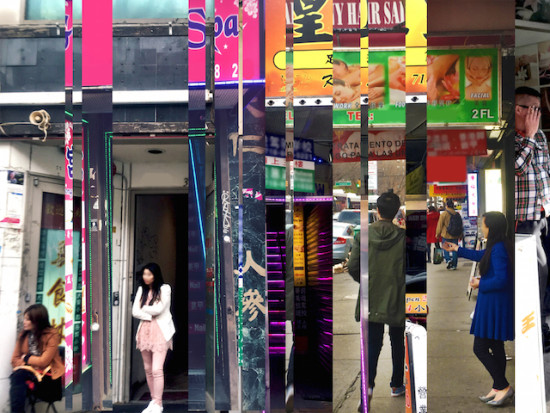Suran Song turned a laundromat in Jackson Heights into a space for private reflection. Now she’s inviting her neighborhood to practice yoga in her living room.
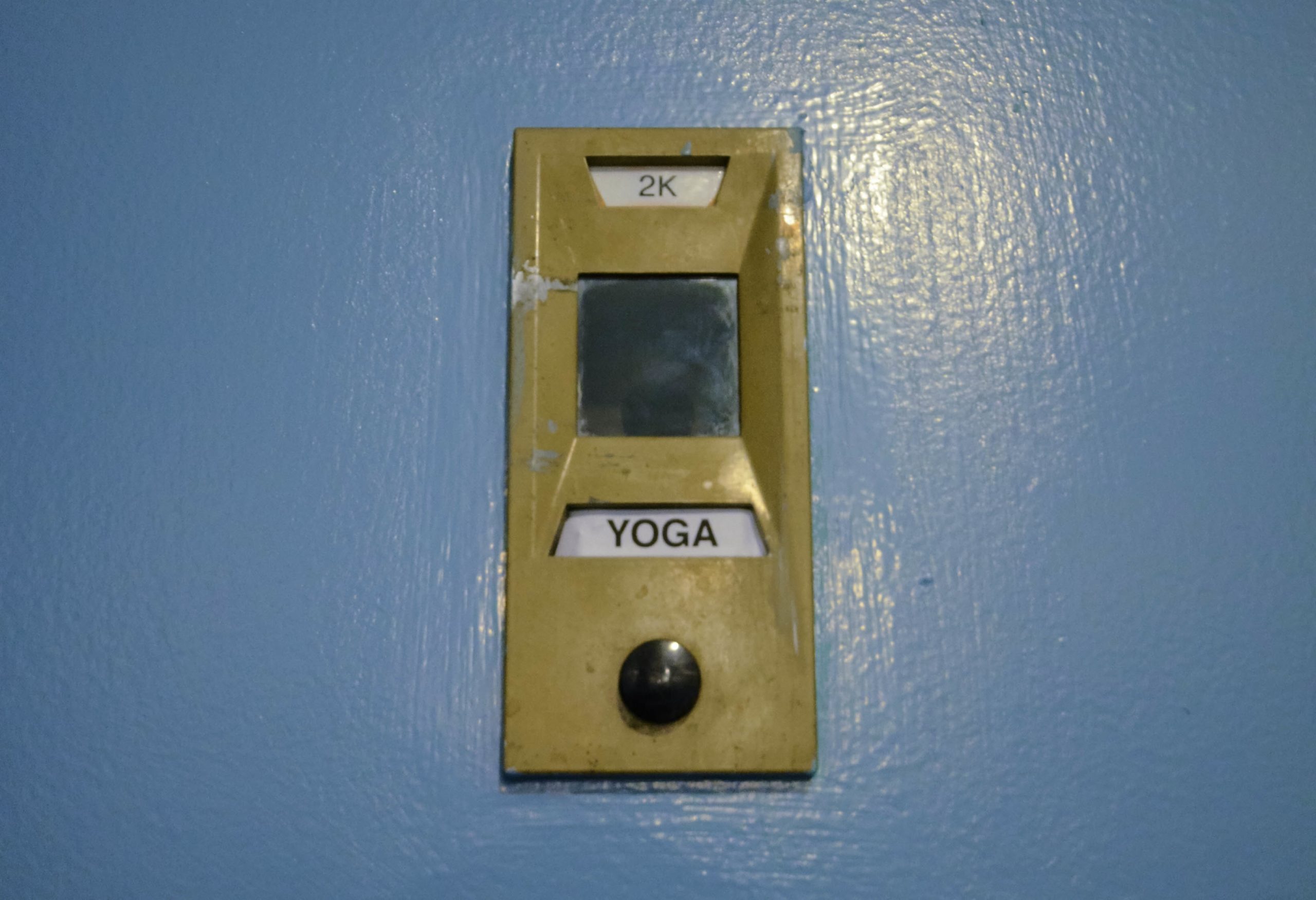
September 18, 2013
A little boy thrusts a card towards me as I angle off Elmhurst Avenue onto 91st Street. I lean over in stride, gently tug it out of his hands, and smile. Most days, I’m ambivalent about whether I’ll take flyers on the street (folks are just hustling, right?) or politely “no thank you” my way on by (got places to go, man) but this four-year-old is too earnest to reject without suffering pangs of guilt. I quickly eyeball the promo material for Aquario Salon and realize my destination isn’t far off.
I’m en route to see Suran Song, a performance and visual artist who maintains a local yoga studio in Jackson Heights. Arriving on the 2nd floor of the red brick apartment building, I scan the row of blue doors for “SONG.” Nothing. Then, I spot the word “YOGA” printed on a peephole label. Of course.
When she answers the door, Song and I have a quick chuckle about the label as I acclimate to what feels and looks like a full-fledged yoga studio. Warm lighting, hardwood floors, bright greens, purples, reds. Song explains that after seven years in Jackson Heights, she and her partner agreed to sacrifice much of the space in their home—save the kitchen and the bedroom—for the purpose of a public yoga space.
Her broad portfolio of colorful mandalas and yoga action paintings (body impressions of yoga poses on paper) line the walls revealing that yoga and art are indeed the self-same practice for her. Decades ago, as part of her work as a ceramicist in his production department, pop artist Peter Max directed Song to paint a swami’s face on hundreds of plates. This repetitive task was an unconscious meditation—and a step towards her discovery of the very conscious practice of yoga long before she had ever held a pose. Eventually, after experimenting as a punk rock vocalist, Song studied a Himalayan style of yoga that has become the backbone of her artistic expression. Last year, she even tried yoga-integrated performance art inside the JH Laundromat on 37th Avenue, not far from her home.
The path to her yogic home winds not only through the residential blocks of eastern Jackson Heights, but through an eclectic family history. Her father, a Socratic-loving intellectual left Korea rejecting Eastern thought and religion. Her mother, a Greek Midwesterner from a clan of restaurateurs and merchants, emigrated to Michigan through Astoria.
I’ve also heard that Suran speaks Esperanto–a universal language invented by a Polish ophthalmologist that’s still spoken by thousands (and maybe millions) worldwide.
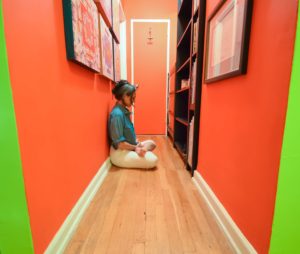 Suran Song rests below an array of mandalas she’s created–each one is chanted over numerous times during its creation.
Suran Song rests below an array of mandalas she’s created–each one is chanted over numerous times during its creation.
Esperanto?
My grandmother and grandfather actually started the Korean Esperanto club. People think really negatively of it, but it was just invented to be a simple language. And it was pretty connected to the Communist movement at the time. That’s how my grandparents met. They eloped from there.
So did you grow up speaking Esperanto?
Well, my grandmother didn’t know English that well. She spoke Korean, Esperanto, and Japanese. I never sat down and learned it, but I would overhear it. So I had like a pidgin Esperanto/Korean/Japanese. And I spoke to my grandmother in those three (laughs heartily). I never went to look at its structure and so I don’t really know it. For my dad, it was always about finding common language. For him, that eventually was English. That’s also probably part of that generation. WWII. A “liberating language.” So, I think that the idea of Esperanto or English as compared to Korean was also something that probably really appealed to him.
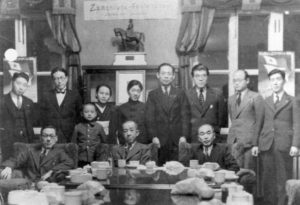
There are a bunch of influences at play for you. How does that connect at all to the intense multiculturalism you see here in Jackson Heights?
It makes me so excited to be here. I feel like Jackson Heights is a unique microcosm. It’s not like any other place that I’ve been in in the world.
And in your home studio? What does the community that comes here look like?
It depends on who comes and which night. It’s really wonderful. We get grandmothers. I get 16-year-old kids, 10-year-olds. I get mothers, I get fathers, I get couples. Colombians, Peruvians, Mexicans, Chinese… some Tibetan ladies have come, and then some Indian ladies have come. Sikhs too. It’s just people. People just show up. For the most part it’s people who are really adventuresome. They’ll go up to a second floor apartment to someone they’ve never met before and do yoga together. It’s kind of, in that way, the common denominator—that everyone has a nice, adventuresome spirit.
I understand you taught yoga at a laundromat?
I just wanted to put it out in a way that was swadeshi. Gandhi talks about the neighborhood republic. So, I wanted to work within a few block radius of where I lived and serve the neighbors more than the people going to a rarefied place… It was to make it accessible to people who’ve always wanted to try, but never had the time to go do it. And I love the laundromat! You’re cleaning your inside and your clothes! (laughs) It was great. I wouldn’t have done this (gestures around studio) without that. This came from people there, saying they enjoyed the project. It was so useful to people. I just feel it was really where it belongs. I kinda don’t understand why more yoga teachers don’t put it out on the street that way. Or put it out where people can taste it. If it hadn’t been about doing it in the laundromat, I wouldn’t have thought about creating another space for it.
In some parts of the city, when people open up a yoga studio, it usually comes with the same warning label as a new Starbucks, you know “beware the ides of gentrification” and such. How is your yoga studio different?
So much of it is about being at home… in your body, being friends with your mind. For people coming here, making home, who just left home, I thought it would be a really good…a good service. And maybe, in terms of social sculpture, it could put into place some ways to maybe make art, sort of performance art. I really wanted it to be affordable and to be something that you could just do like taking a walk, not a big set-aside time or like $25 bucks to go to it and then it becomes really rarefied. In the places that I’ve been teaching in—spas, clubs, and retreats—there, it’s this thing you do to relax when you’re really, really stressed and you go back only when you’re stressed out again. Bringing it at home and setting up the space to make it easy for people to come was important. On Tuesdays it’s by donation, so you pay what you want. I want to do it this way cause I also just wanted, in terms of making artwork, to see if there could be a bit of an impact that I could make in my neighbors’ lives.
Anyone that’s an immigrant and goes to live in another country, to me, they’re artists par excellence. I mean, they’re completely creating.
I suppose as a yoga instructor you end up having an ability to read people and what’s stressing them. What are those things that folks in Jackson Heights are bringing to the space?
Most people who come are looking for health benefits. There are a lot of folks who just arrived here within a year or two. They’re really stressed out. People have a hard time sleeping, just worried about money and worried about work, and can’t sleep. Then it really takes such a toll on your whole system, so I made the classes in the late evening, after work, so we could do deep relaxation.
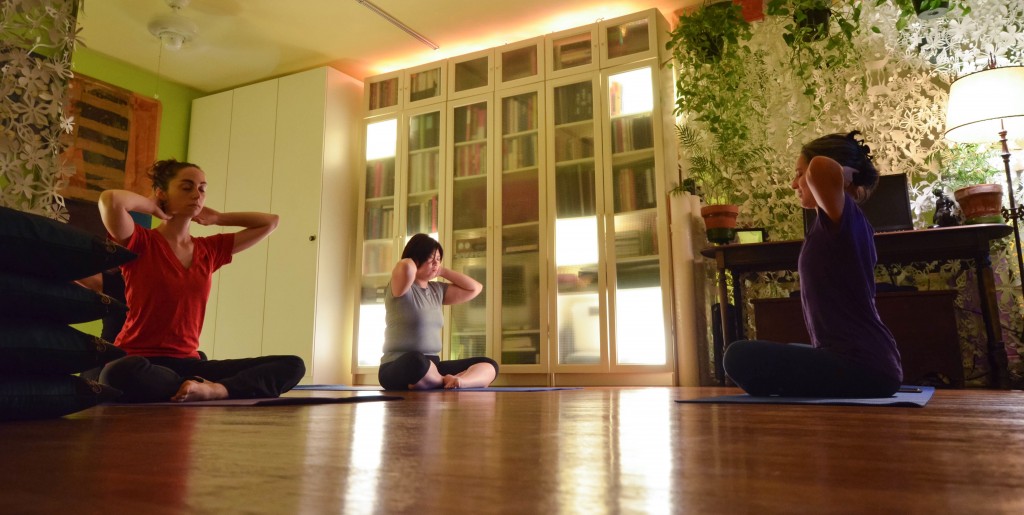
Is there something about the immigrant experience that brings up some particular stresses?
I think it’s the quintessential American experience and I think it’s just the idea of the bravery of leaving home. There’s a lot of creativity that needs to happen. Anyone that’s an immigrant and goes to live in another country, to me, they’re artists par excellence. I mean, they’re completely creating.
Immigration as an act of art?
I mean, it takes so much to leave all the conditioning and come in and learn a whole other set of conditioning and then figure out, you know, which conditionings are going to serve a more peaceful purpose: which conditionings from old world drop away, and which ones from here you take, and so on.
To what degree is your yoga practice a spiritual one?
It’s pretty much completely devotional.
This past July, a group of South Asian practitioners launched a new initiative aimed at recognizing the vital role of South Asians in the practice of yoga, and in many ways seeking to reconnect the practice to its cultural lineage and spiritual tradition. They held a talk at the Brecht Forum to discuss some of the issues with cultural appropriation and secularization of the practice. What do you think of those issues in American yoga?
That’s a great question. The question of authenticity and xenophobia—if you get too polarized in one camp or another, that interlacing becomes complicated and difficult and the simple way to do it is just to say “yes” and “yes.” And to work with being aware of not offending, but at the same time there’s got to be a willingness to extend for others to have their own cultural lens. That’s part of the kaleidoscope that’s creation.
Do you think it’s even possible for a genuine practice of yoga to survive without a spiritual basis? I mean there are yoga competitions and even an attempt to put yoga in the Olympics.
It’s really about un-conditioning your own belief in your thought processes and your ideas about what’s right and wrong, and this is so inclusive. Everybody is the center point and there isn’t just one. It’s unity through intense kaleidoscopic difference and multiplicity. That’s what I hear in Sanskrit and that’s what I do in yoga. That’s why I think it’s such an important and powerful tool for civil rights.
“Unity through intense kaleidoscopic difference and multiplicity.” Sounds like that could be a slogan for Jackson Heights.
Yeah! You see it on the train. People reading their language newspapers, sitting next to each other, eating their rolls and doughnuts on their way to work.



